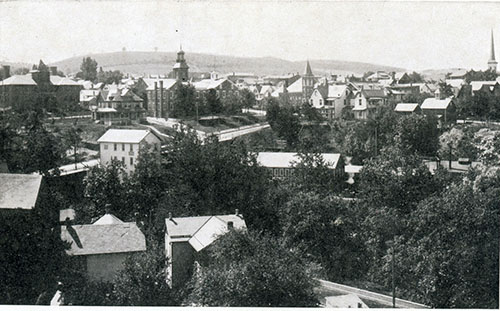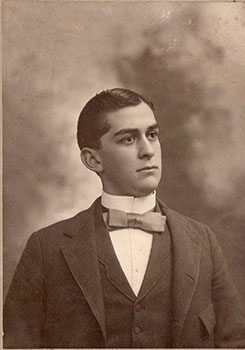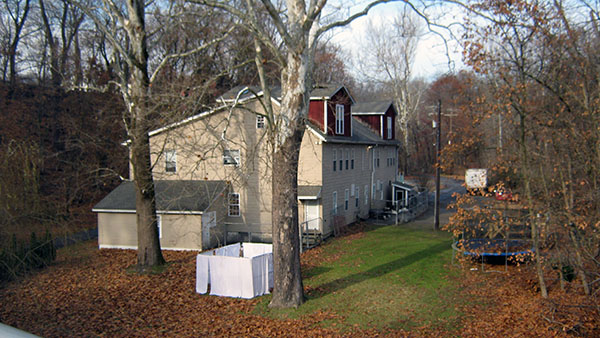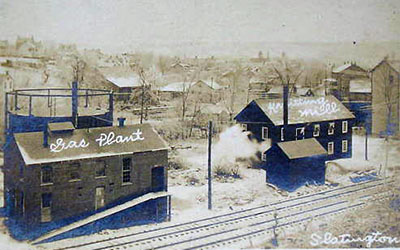In early 1900, James G. Rauch had begun planning for his Slatington News building on the plot of ground that he had acquired north of the Main Street bridge. That plot of land was fairly sizable, and Rauch advertised that there was room for a factory of some kind on the property. (See, for example the ad in The Slatington News, 18 August 1900). By December 1900, Rauch had agreed with Harry Muschlitz to erect a large building on the site along the railroad beyond the Main Street bridge. The plant began active operation sometime in January 1901. It was a 2-story, wood frame building that housed about 30 knitting machines capable of producing 150 dozen stockings per day. Initially, the mill was set up for about 25 workers, but this was later increased to about 75 workers after electric light was added in the mill. (The Morning Call, 18 February 1901, 9 October 1901) The plant was enlarged several times in succeeding years.

Later view of the area around the Crystal Knitting Mill circa 1915
My grandmother often recalled how she went to work in the Crystal Knitting Mill when she turned thirteen. That must have been about 1916. She worked as a “looper,” responsible for attaching the toe portion of a sock or hosiery, and she always said that she liked her job. The owner of the mill was Henry Muschlitz, and my grandmother remembered him as a large man who spoke Pennsylvania Dutch among the workers, thinking that they couldn't understand what he was saying, but she could understand him, since her mom spoke Pennsylvania Dutch.
Henry Albert “Harry” Muschlitz (1877-1923) was the youngest son of Robert and Lovina Boyer, born at Aquashicola, on the east side of present-day Palmerton. He was an important manufacturer in Slatington in the early twentieth century.

Henry Muschlitz, Source Ancestry
A graduate of Slatington High School in 1895, he became a bookkeeper for the Slatington Knitting Co., which had just been organized by Thomas Zellner, William Fritzinger, Robert Muschlitz (a brother) and Frederick Wyle. Harry later became the owner of that mill in 1919. That hosiery factory was located in a two-story building on the northeast corner of Main Street and Center Alley. It is no longer there. At some point in time, Harry became a director of the Penn County Trust Company of Allentown and involved with the Slatington Gas Company. He served as town burgess 1918-1921.
In December 1899 Harry Muschlitz married Carrie Schaeffer (1877-1937), and they had one daughter, Reba (1902-2002). They lived in the Thomas Zellner home, purchased in 1919, on the northwest corner of Main and Franklin Streets. Thomas Zellner (1844-918) had been a prominent slate operator in Slatington.
Harry was the uncle of Dr. Charles Muschlitz.
Harry Muschlitz died on 3 December 1923, and his funeral took place three days later. He was buried in Union Cemetery.
In the summer of 1924, the house, mills and mill machinery were all sold at a public sale. The Crystal Knitting Mill was part of that sale.
In August 1924, it was announced that the building was being converted into a sweater manufacturing plant operating as the National Knit Fabrics Co. of Lehighton aka National Knit Fabric Co. (Lehighton). Elwood Phifer (1872-1933), originally from Parryville, PA, ran the company until his death in January 1933.
For a short while after Phifer’s death, his widow, Emma née Solt (1876-1948) ran the mill before selling it to the R and C Knitting Company aka R. M. C Knitting Co. or R.C. Knitting Co. of Lehighton in late 1934. R and C were short for Pierce Rehrig (1875-1941) and Evelyn Christman (1893-1973). Rehrig drowned in mysterious circumstance in a puddle of water at his cabin in Big Creek Valley (now submerged under Beltsville Lake) in June 1941. Fred Komantowski (1886-1985) was initially charged with third-degree murder in a rather sensational court case, but the murder charge was later overturned by the state supreme court as the death might have been suicide or simply an accident. In addition, Pierce’s widow, Emma née Acker, 1875-1962, went to court against Evelyn Christman, charging her with fraud and coercion to obtain total control of the mill business. I am not sure how that court case turned out.
At some point in the late1930s, the Gem Undergarment Co. operated in the building. Then, in December 1940 Gem moved to the old Silk Mill building in nearby Slatedale.
By 1952, the Gloria Manufacturing Company started operations in the building. The firm, which manufactured dresses and employed eventually about 100 people, was owned by Andrew Pelosi (1912-1985) who managed the company until his retirement in the 1970s. He had previously been associated with the McCall Dress factory in Palmerton. Burnetta Evans Martin (1920-2000), the wife of my grand uncle, was a sewing machine operator at Gloria for over thirty years.
In the 1980s the building changed hands several times, first as Samantha Fashions Factory Outlet for children and women’s wear, then Sewitsems Inc., and finally Tere Manufacturing.
By the 1990s, it had been converted into condominiums.
When we were kids, it was still an active dress factory as the Gloria. We would often prowl around the loading dock area looking for empty thread spools or other interesting items. During the winter, we would go there looking for cardboard boxes that we could use to go sliding down the nearby Shooky's hill.
It also seems to me that the working hours of the mill were in tune with the school hours. Usually around three o'clock in the afternoon, just before the schools let out for the day, there would be a short stream of cars leaving the mill and coming up the road behind our house, as the women raced home from the mill before the kids got home from schools. Our miniature collie, if he got out of our yard, would always chase the cars, like he was herding sheep. He'd get very close to the cars, but he never got hit.

The former Crystal Knitting Mill viewed from the Main Street bridge, 2023
